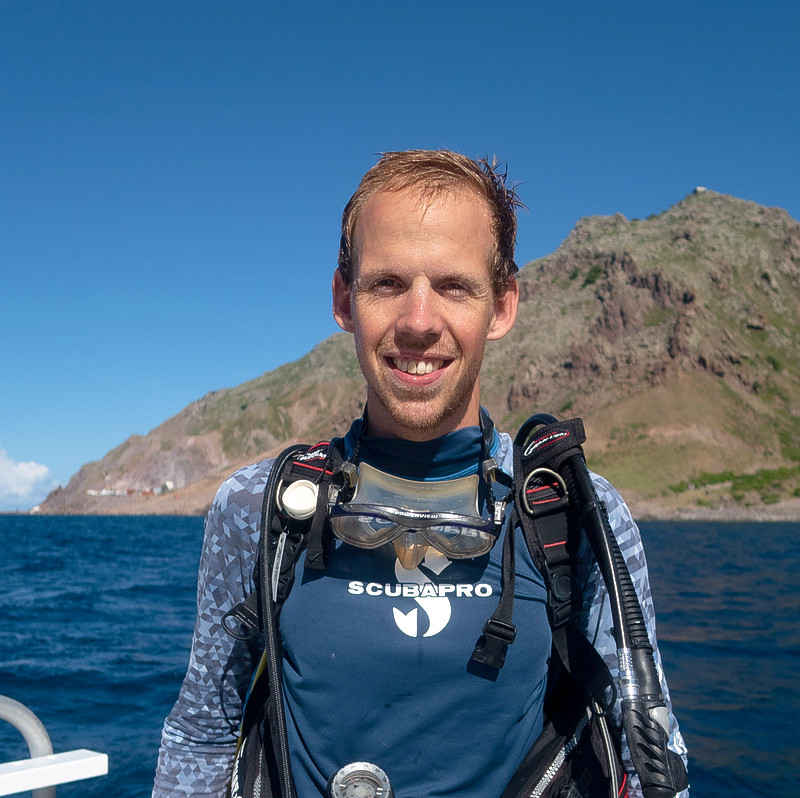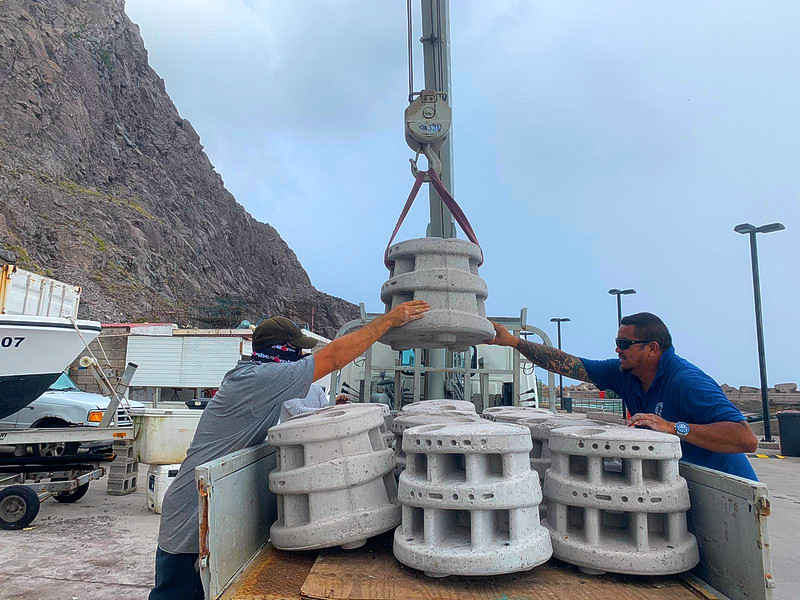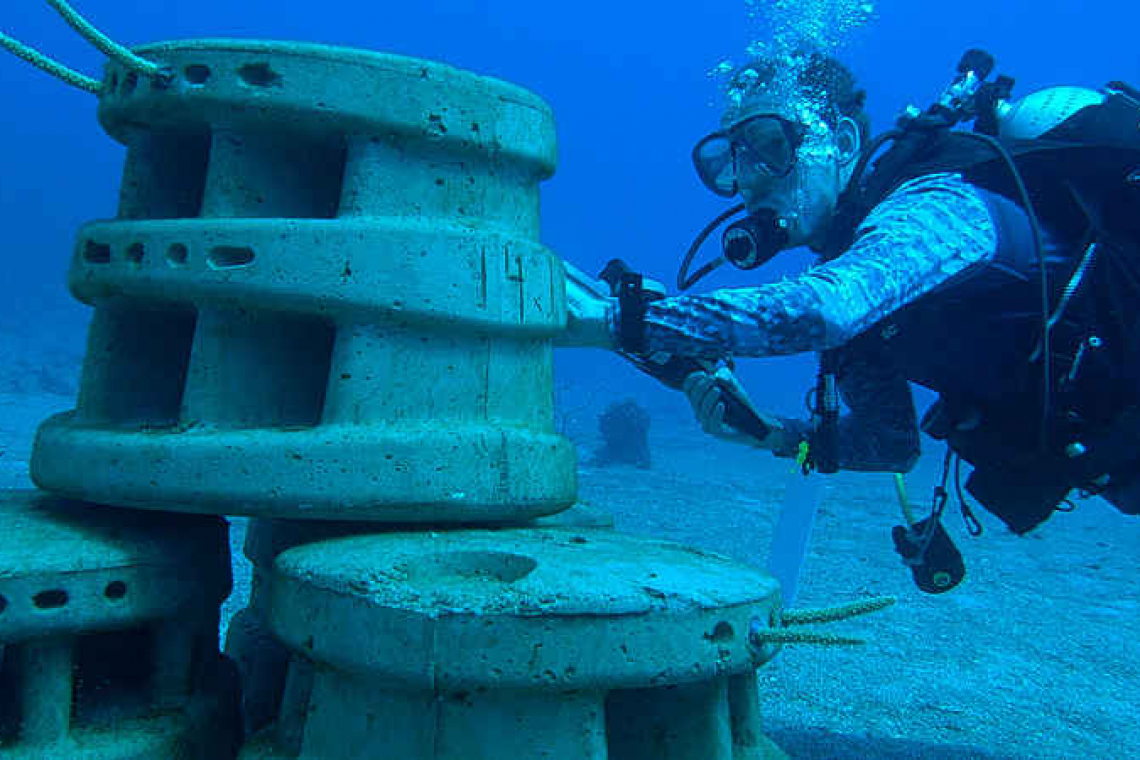Alwin Hylkema securing coral in place.
SABA--Everyone must strike out on their own. It is something many parents discuss with their children. For Alwin Hylkema, the founder of Modular Restoration Reef Moreef in Saba, this question bears a special relevance as he works to improve the health of reefs.
Moreef, a not-for-profit organisation founded in 2019, seeks to provide low-cost, high-appeal artificial reefs for marine life to utilise as habitats. Its work began on the island of Saba and has continued operating throughout the pandemic.

Another day in the office for Alwin Hylkema.

The Moreef team loading the Moreef units for deployment in Saba’s Fort.
The idea came from Hylkema’s research in the Artificial Reefs on Saba and Statia AROSSTA project through the University of Applied Sciences Van Hall Larenstein (VHL) located in Leeuwarden, Netherlands. The project examined the efficacy of previous artificial reef structures and found that most artificial reefs are too bulky and heavy for easy transportation, while other, lighter models, are too small to withstand large storms and hurricanes.
Additionally, they often fail to facilitate the desired coral growth. Moreef was developed. This lighter, more spacious artificial reef is formed from a polyester mould and filled with concrete. The end product weighs in at 150 kilograms. It is easier to move both above and below the surface. When deployed, they can be stacked and connected, forming a larger and stronger reef, better able to withstand tropical storms. Most importantly, Moreef has been shown to locally increase marine life, it was stated in a press release.
Hylkema aims to spread Moreef’s approach to other islands in the Caribbean and beyond. The polyester moulds and supporting equipment will be sold to anyone interested in helping restore this vital species of ocean herbivore.
In Saba, VHL, together with the Saba Conservation Foundation (SCF) work on replenishing the endemic long-spined sea urchin (diadema antillarum) and the restoration of coral ecosystems. This species plays an important role in the maintenance of local ecosystems. As one of the key herbivores on any Caribbean reef, they help keep coral structures free from algae and assist with the regrowth of coral on damaged reefs.
In 1983, however, this species of urchin experienced a mass die-off throughout the Caribbean due to an unknown disease. As such, reefs are at risk as algae may increase, suffocating adult coral and preventing the growth of new coral. Without this important species, Hylkema warns that Caribbean coral reefs will lose their ability to recover from any damage done by hurricanes, climate change, anchoring or fishing, as the bare substrate is quickly colonised by algae.
The diadema sea urchins help maintain the reefs’ delicate balance. The pristine nature of Saba’s reefs will be maintained by restoring the local population of long-spined sea urchins. This, according to Hylkema, will also help with coral restoration efforts: “So much effort has been directed towards coral restoration that nature agencies have ignored the wider conditions required; without a sustained focus on keeping reefs clear of algae, any effort will fall short of its aimed goal,” it was stated in the release.
Hylkema remains a researcher at VHL. On the island of Saba, he works in close collaboration with the SCF and is supported by a team of international student interns.
The team’s current research focuses on the sea urchin’s reproductive cycle and the question: how best to raise sea urchins outside of the ocean?
This process begins with the collection of juvenile sea urchins on larvae collectors. Their high surface area provides plenty of room for the young urchins to latch onto and are collected on a monthly basis by the researchers.
From there, the urchins are divided into tanks of roughly 20 individuals against which various conditions of nutrients, salinity, and temperature can be tested to achieve the best results for growth. Roughly 70 per cent of specimens survive this stage and are able to be transplanted onto Saba’s outer reefs.
Future research plans for the year aim to study the optimum method for restocking urchin populations. Keeping the juveniles in the land-based tanks for too long has repercussions; transplanting them on the reef when they are too small results in high mortality rates. Over the next two-to-three years, Hylkema and his team will determine the best period, area, and shelter needed to achieve the highest survival rate of these endangered urchins.
VHL works closely with the SCF. The latter is charged with the preservation of Saba’s natural environment and the national park which encompasses the island. To do this, it maintains the 20 hiking trails which provide visitors with easy access to Saba’s terrestrial beauty, while at sea it provides moorings for Saba’s 30 dive sites ranging from sloping reefs to dramatic drop-offs and renowned pinnacles.
Transportation to and from the research site is provided by both the SCF and Sea Saba Dive Center. Sea Saba Dive Center supports the work of Moreef.
Persons can follow the project on Facebook and schedule an urchin restoration dive or join the team for Sea and Learn in 2021, where Hylkema will be a presenter. Saba has protected its local community from COVID-19 throughout the global pandemic. It will reopen to tourism on May 1, 2021, following a vaccination drive.







